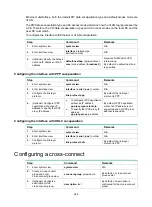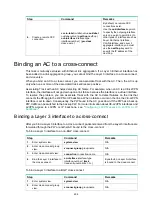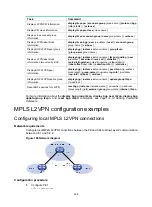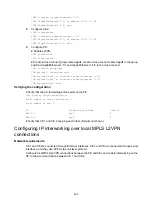
394
Control word
The control word field is between the MPLS label stack and the Layer 2 data. It carries control
information for the Layer 2 frame, for example, the sequence number.
The control word feature has the following functions:
•
Avoids fragment disorder. In multipath forwarding, fragments received might be disordered. The
control word feature reorders the fragments according to the sequence number carried in the
control word field.
•
Transfers specific Layer 2 frame flags, such as the FECN bit and BECN bit of Frame Relay.
•
Identifies the original payload length for packets that include padding.
When the PW data encapsulation type is FR DLCI, packets on the PW always carry the control word
field, and the control word feature cannot be disabled.
When the PW data encapsulation type is Ethernet or VLAN, the control word field is optional. You
can configure whether to carry the control word field in packets sent on the PW. If you enable the
control word feature on both PEs, packets transmitted on the PW carry the control word field.
Otherwise, the packets do not carry the control word field.
MPLS L2VPN interworking
CEs might connect to PEs through various types of links, such as FR, HDLC, Ethernet, and PPP.
MPLS L2VPN interworking connects such CEs and allow them to communicate.
MPLS L2VPN supports Ethernet interworking and IP interworking modes. The device only supports
IP interworking. Only local MPLS L2VPN connections, static PWs, LDP PWs, and remote CCC
connections support the interworking feature.
Figure 103 Ethernet to PPP interworking
As shown in
, a packet in an MPLS L2VPN interworking scenario is forwarded as follows:
1.
CE 1 sends an Ethernet frame destined for CE 2 to PE 1.
2.
PE 1 checks whether the packet encapsulated in the received Ethernet frame is an IP packet.
{
If yes, PE 1 removes the Ethernet header, adds PW label V and tunnel label T to the IP
packet, and forwards the packet to PE 2 through the tunnel.
{
If not, PE 1 drops the frame.
3.
PE 2 obtains the output interface according to the PW label V in the received packet, removes
the PW label, adds an PPP header, and forwards the PPP frame through the output interface to
CE 2.
In an MPLS L2VPN interworking scenario, link layer negotiation packets cannot be delivered on the
backbone network. Therefore, Layer 2 connections cannot be established between CEs. CEs must
MPLS or IP backbone
Ethernet link
PPP link
CE 1
PE 1
CE 2
PE 2
V
T
IP header
IP data
IP header
IP data
PPP header
Eth header IP header
IP data
V: PW label
T: Tunnel identifier
















































